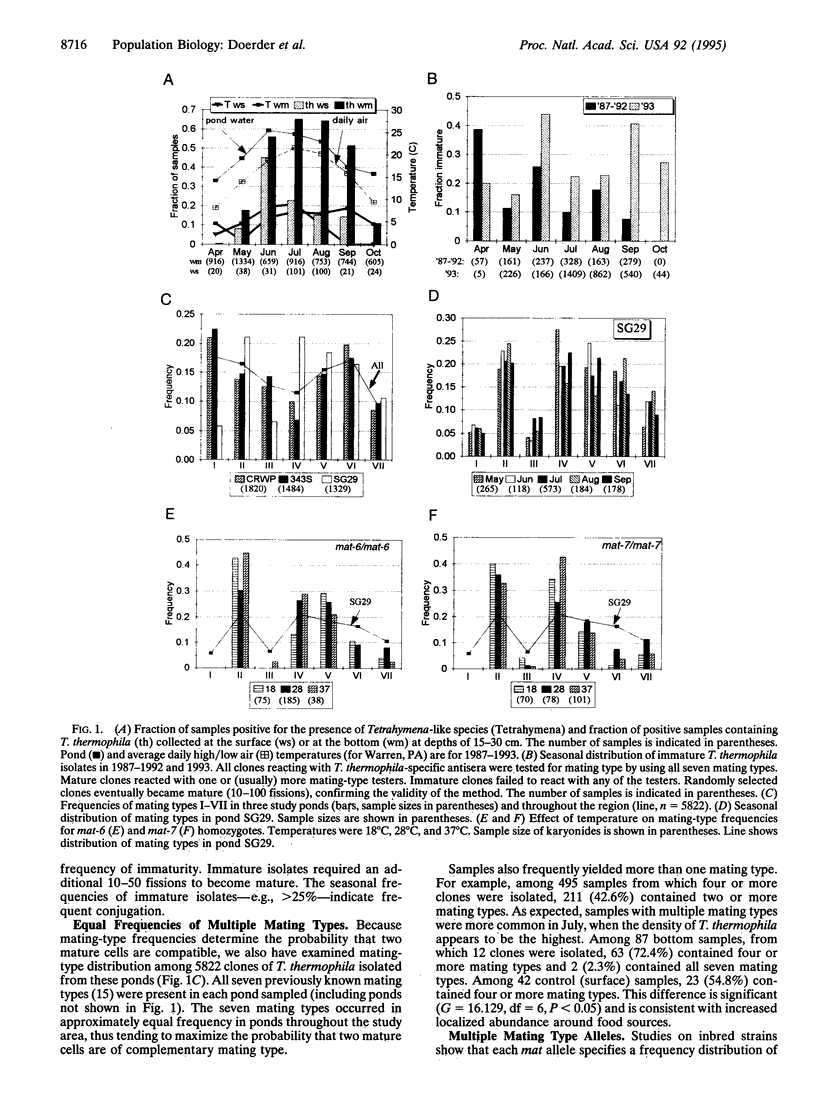Abstract
In ciliate protists, sex involves the temporary joining of two cells of compatible mating type, followed by meiosis and exchange of gametic nuclei between conjugants. Reproduction is by asexual binary fission following conjugation. For the many ciliates with fixed multiple mating types, frequency-dependent sex-ratio theory predicts equal frequencies of mating types, if sex is common in nature. Here, we report that in natural populations of Tetrahymena thermophila sexually immature cells, indicative of recent conjugation, are found from spring through fall. In addition, the seven mating types occur in approximately equal frequencies, and these frequencies appear to be maintained by interaction between complex, multiple mat alleles and environmental conditions during conjugation. Such genotype-environment interaction determining mating type frequency is rare among ciliates.
Full text
PDF



Selected References
These references are in PubMed. This may not be the complete list of references from this article.
- Allen S. L., File S. K., Koch S. L. Genomic exclusion in tetrahymena. Genetics. 1967 Apr;55(4):823–837. doi: 10.1093/genetics/55.4.823. [DOI] [PMC free article] [PubMed] [Google Scholar]
- Doerder F. P., DeBault L. E. Life cycle variation and regulation of macronuclear DNA content in Tetrahymena thermophila. Chromosoma. 1978 Oct 20;69(1):1–19. doi: 10.1007/BF00327377. [DOI] [PubMed] [Google Scholar]
- Finley M. J., Bruns P. J. Costimulation in Tetrahymena. II. A nonspecific response to heterotypic cell--cell interactions. Dev Biol. 1980 Sep;79(1):81–94. doi: 10.1016/0012-1606(80)90074-3. [DOI] [PubMed] [Google Scholar]
- Leick V., Hellung-Larsen P. Chemosensory behaviour of Tetrahymena. Bioessays. 1992 Jan;14(1):61–66. doi: 10.1002/bies.950140113. [DOI] [PubMed] [Google Scholar]
- McCoy J. W. Kinetic studies on the mating reaction of Tetrahymena pyriformis, Syngen 1. J Exp Zool. 1972 May;180(2):271–277. doi: 10.1002/jez.1401800213. [DOI] [PubMed] [Google Scholar]
- Nanney D L, Caughey P A, Tefankjian A. The Genetic Control of Mating Type Potentialities in Tetrahymena Pyriformis. Genetics. 1955 Sep;40(5):668–680. doi: 10.1093/genetics/40.5.668. [DOI] [PMC free article] [PubMed] [Google Scholar]
- Nanney D L. Genetic Factors Affecting Mating Type Frequencies in Variety 1 of Tetrahymena Pyriformis. Genetics. 1959 Nov;44(6):1173–1184. doi: 10.1093/genetics/44.6.1173. [DOI] [PMC free article] [PubMed] [Google Scholar]
- Nanney D. L., Doerder F. P. Transitory Heterosis in Numbers of Basal Bodies in TETRAHYMENA PYRIFORMIS. Genetics. 1972 Oct;72(2):227–237. doi: 10.1093/genetics/72.2.227. [DOI] [PMC free article] [PubMed] [Google Scholar]
- Nanney D. L., Meyer E. B., Chen S. S. Perturbance analysis of nuclear determination in Tetrahymena I: background, rationale, and illustrative example, employing temperature responses. Differentiation. 1977 Oct 20;9(1-2):119–130. doi: 10.1111/j.1432-0436.1977.tb01525.x. [DOI] [PubMed] [Google Scholar]
- Nanney D. L., Meyer E. B., Portnoy S. Perturbance analysis of nuclear determination in Tetrahymena: effects of nutrition, cell extracts, and CaCl2 on A/B hybrids. Differentiation. 1980 Feb;16(1):49–60. doi: 10.1111/j.1432-0436.1980.tb01057.x. [DOI] [PubMed] [Google Scholar]
- Orias E., Bruns P. J. Induction and isolation of mutants in Tetrahymena. Methods Cell Biol. 1976;13:247–282. [PubMed] [Google Scholar]
- Phillips R. B. Mating-type alleles in Illinois strains of Tetrahymena pyriformis, syngen 1. Genet Res. 1968 Apr;11(2):211–214. doi: 10.1017/s0016672300011393. [DOI] [PubMed] [Google Scholar]
- Smith D. L., Berkowitz M. S., Potoczak D., Krause M., Raab C., Quinn F., Doerder F. P. Characterization of the T, L, I, S, M and P cell surface (immobilization) antigens of Tetrahymena thermophila: molecular weights, isoforms, and cross-reactivity of antisera. J Protozool. 1992 May-Jun;39(3):420–428. doi: 10.1111/j.1550-7408.1992.tb01475.x. [DOI] [PubMed] [Google Scholar]
- Weindruch R. H., Doerder F. P. Age-dependent micronuclear deterioration in Tetrahymena pyriformis, syngen 1. Mech Ageing Dev. 1975 May-Aug;4(3-4):263–279. doi: 10.1016/0047-6374(75)90028-7. [DOI] [PubMed] [Google Scholar]


